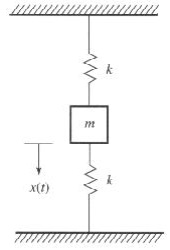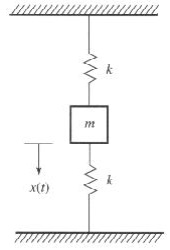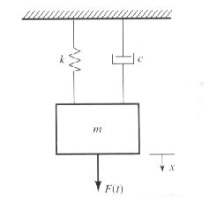Assignment:
Question 1. What is the equation of motion for the idealized model shown?

Question 2. For the idealized system shown, what is the natural circular frequency in rad/sec, and the period of oscillation in seconds?

Question 3. The equivalent spring constant of two parallel springs with spring constants
20 lb/in., and 50 lb/in. is:
Question 4. A Mass-Spring-Damper system is tested to determine the value of the viscous damping coefficient c. Assume k =150 N/m and m = 30 kg. The vibrational amplitude is observed to decrease to 33% of its initial value after two consecutive cycles. What is the value of the logarithmic decrement?
Question 5. A Mass-Spring-Damper system is tested to determine the value of the viscous damping coefficient c. Assume k =150 N/m and m= 30 kg. The vibrational amplitude is observed to decrease 33% of its initial value after two consecutive cycles. What is the value of the viscous damping ratio?
Question 6. A Mass-Spring-Damper system is tested to determine the value of the viscous damping coefficient c. Assume k= 150 N/m and m = 30 kg. The vibrational amplitude is observed to decrease to 33% of its initial value after two consecutive cycles. What is the value of the viscous damping coefficient c?
Question 7. In the idealized model shown, m = 15 kg, k = 135 N/m, and the viscous damping ratio is 0.15. Assume that an external harmonic force F(t) = 15 cos 4 t acts on the system with F0=15 N and forcing frequency of 4 rad/s. Find the magnification factor M for the frequency ratio r of 1.382
